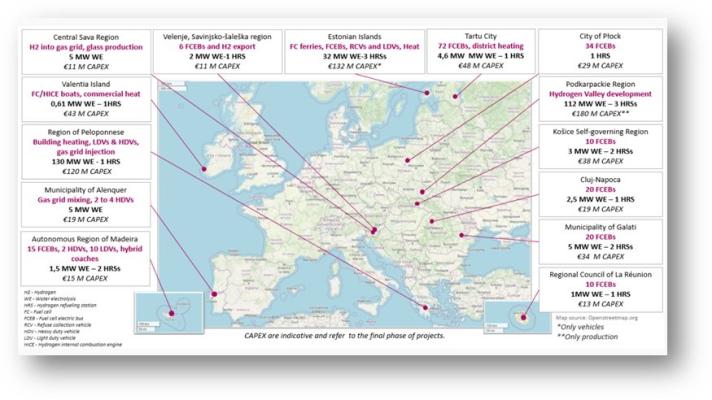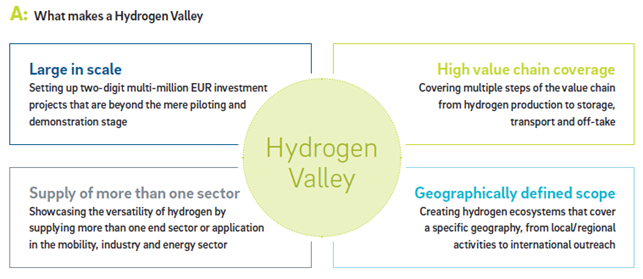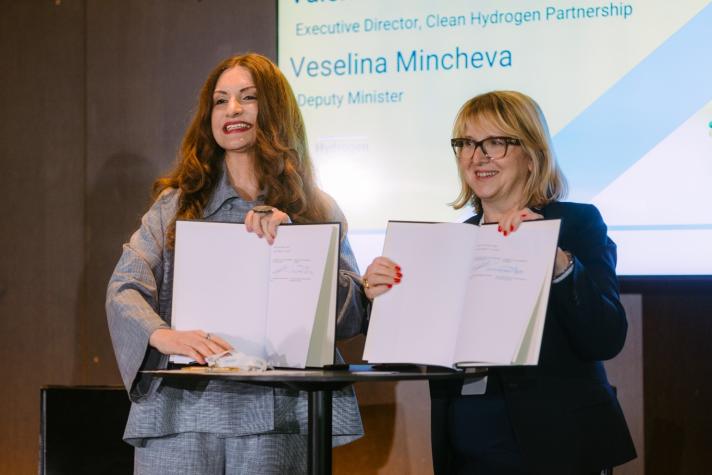
We work with European regions and cities to implement fuel cell and hydrogen (FCH) technologies, helping them achieve their decarbonization and growth objectives.
The origin of Hydrogen Regions
Support for research and Innovation under the first FCH Joint Undertaking (2008-2013) was essential to the development of fuel cells and hydrogen-based applications. As these technologies matured, the FCH 2 JU (2014-2020) started to support the demonstration of energy and transport applications at large scale (fleets of buses, domestic heat and power systems, garbage trucks, etc). In parallel, hydrogen production technologies, and in particular the production of hydrogen through the electrolysis of water using renewable electricity, advanced significantly, with production capacities increasing in the last 10 years from several hundred kWs to multi-MW scale plants.
As hydrogen technologies matured, since 2016, the JU undertook significant efforts to reach out to all those European regions and cities having an interest in the potential use of fuel cell and hydrogen-based solutions to help them achieve their decarbonisation goals. As a result, the JU launched the FCH-Regions Initiative to support regions across Europe in assessing the business cases for fuel cell and hydrogen applications and in mapping their local capabilities so that they can be exploited in the future. This initiative attracted 89 European regions and cities from 22 European countries which were actively working to shape their green energy transitions with hydrogen and fuel cells. As part of the FCH-Regions initiative, the JU study on Fuel cells and hydrogen for green energy in European cities and regions, published in 2018, identified project implementation intentions in excess of EUR 1.8 billion over a 5-year period. Since then, the JU has been working closely with regions to realise this potential, while continuing to support R&I to improve the performance and reduce the cost of clean hydrogen technologies across the whole value chain. The period following the end of the FCH-Regions Initiative and building on the momentum it created, saw the launch in May 2019 of the European Hydrogen Valleys Partnership (EHV-S3P) under the Smart Specialisation Platform. The EHV-S3P aims at facilitating exchanges of knowledge and practices between regions, strengthening the European hydrogen value chain and promoting the concept of hydrogen valleys.
For regions and cities willing to get familiar with hydrogen technologies as well as on how they can help to decarbonise their territories, the FCH-Regions initiative provide a series of technology dossiers and preliminary business cases.
Project development assistance
Following the FCH-Regions Initiative, the JU launched in 2019, a pilot project development assistance (PDA) facility to help develop detailed project planning in regions and cities with a lower maturity level, with a special focus on central and eastern Europe. The final report covering the results of this initiative was presented in a webinar on 19 October 2021, with the participation of some of the regions involved and representatives from the European Commission and the European Investment Bank. The PDA initiative supported 11 selected regions to develop detailed work plans for the implementation of hydrogen projects. It concluded in June 2021. The report contains summaries of the project plans and work undertaken in each of the selected regions, the activities delivered as part of the observer network, and the next steps after the end of the PDA support period. The pilot PDA for hydrogen in regions set the path for further such initiatives, targeting regions that are not yet involved in the development of hydrogen projects and could make use of the encompassing advantages of hydrogen as a green energy carrier to ensure local, sustainable and integrated energy solutions.

Building on the success of the pilot PDA initiative, the Project Development Assistance (PDA) for Regions II was launched in 2022, with a clear focus on EU Cohesion Countries, European islands and Outermost Regions. In January 2023, 14 regions from a total of ten different countries were selected to receive support in the framework of this initiative. The projects proposed by the regions cover a wide range of hydrogen applications, from hydrogen buses in the cities to ferries that connect island communities as well as industrial applications such as glass manufacturing. The selected regions have received targeted support from dedicated teams of hydrogen consultants, thus allowing to further develop their project plans and advancing the deployment of fuel cell and hydrogen technology in areas that have seen limited hydrogen deployments to-date. The PDA II has not only provided support to the selected region, but it has also produced a set of recommendations. The final report of the PDA II is available here.


From Hydrogen Territories to Hydrogen Valleys
Against the above backdrop, since 2015, when the JU launched for the first time a call to support a first Hydrogen Valley (referred to at the time as a Hydrogen Territory), the hydrogen valley concept has gained traction among the hydrogen community. Projects such as BIG HIT (Call 2015), HEAVENN (Call 2019) and Green Hysland (Call 2020) have become pioneers and flagships of this concept.
Hydrogen Valleys are hydrogen ecosystems that cover a specific geography ranging from local or regional focus (e.g. industrial cluster, ports, airports, etc.) to specific national or international regions (e.g. cross border hydrogen corridors). Hydrogen Valleys showcase the versatility of hydrogen by supplying several sectors in their geography such as mobility, industry and energy end uses. They are ecosystems or clusters where various final applications share a common hydrogen supply infrastructure. Across their geographic scope,
Hydrogen Valleys cover multiple steps in the hydrogen value chain, ranging from hydrogen production (and often even dedicated renewables production) to the subsequent storage of hydrogen and distribution to off-takers.

Hydrogen Valleys are hydrogen ecosystems that cover a specific geography ranging from local or regional focus (e.g. industrial cluster, ports, airports, etc.) to specific national or international regions (e.g. cross border hydrogen corridors)190. Hydrogen Valleys showcase the versatility of hydrogen by supplying several sectors in their geography such as mobility, industry and energy end uses. They are ecosystems or clusters where various final applications share a common hydrogen supply infrastructure. Across their geographic scope, Hydrogen Valleys cover multiple steps in the hydrogen value chain, ranging from hydrogen production (and often even dedicated renewables production) to the subsequent storage of hydrogen and distribution to off-takers.
REPowerEU with Hydrogen Valleys
Building on the above activities, Hydrogen Valleys have been identified in the RePowerEU plan as a essential in order to scale up Europe’s hydrogen economy. This is the case because they bring together clean hydrogen production, storage of hydrogen and distribution to end-uses while creating regional value chains. Acknowledging the role of the Clean Hydrogen JU in initiating the concept of Hydrogen Valleys and of its initial support, the European Commission allocated to the Clean Hydrogen Partnership an additional €200 million through RePowerEU, to double the number of Hydrogen Valleys in Europe by 2025.
More information on the support of the JU to Hydrogen Valleys available in here.
Synergies with Members States and Regions
With the above in mind, and in view of setting up a more structured cooperation mechanism between the JU and Managing Authorities of Member States and Regions, the JU awarded a contract to identify and design a structured approach to generate and implement synergies on research and innovation activities between the Clean Hydrogen JU and the Managing Authorities.
In 2023, after an exercise to understand the state of the art on the Hydrogen R&I policies of the Member States and third countries associated with Horizon Europe, a Call for Expression of Interest was launched to select 10 regional or national Managing Authorities (MA) to foster a structured cooperation with the JU tailored to the needs of each MA. A meeting with the selected MAs took place during the 2023 edition of the Hydrogen Week. Following this, the work to develop the Memoranda of Cooperation (MoC) started.
The first 3 MoC, with Managing Authorities from Croatia, the Friuli-Venezia Giulia Region of Italy and Bulgaria, were signed during the first edition of the Hydrogen Valleys Days.

Six more MoC, with Médio Tejo Region (Portugal), Castilla y Léon (Spain), Wielkopolska Region (Poland), Košice Self-governing Region (Slovakia), Noord-Holland (The Netherlands) and Slovenia will be signed during European Hydrogen Week 2024, in a dedicated session on 21 November. The MoC with Turkey was signed in early 2025.
The final report regarding this tender has been published. This report offers a description of the work done, including the template developed for the Memorandum of Cooperation, and lessons learnt.
Clean Hydrogen Mission – Hydrogen Valleys go global
In parallel to the above, the ‘Clean Hydrogen Mission’ led by European Union, Australia, Chile, the UK and the US aims to make clean hydrogen cost competitive to the end user by reducing end-to-end costs to USD $2 per kilogram by 2030. To achieve this goal, the Mission will increase research and development in hydrogen technologies h deliver at least 100 large-scale clean Hydrogen Valleys, and at least three per Mission Innovation Member. In this context, in 2021, the JU released the Hydrogen Valley Platform (H2VP) under the umbrella of Mission Innovation’s ‘Renewable and clean hydrogen’ innovation challenge. It aims primarily at project promoters, but it is also raising awareness among policymakers and is intended to inspire others willing to replicate similar projects. The platform was launched publicly in January 2021 at it included 34 Hydrogen Valleys. A first report summarising the situation at this time is available in here. A new tender was launched (December 2021) to give continuity to the Hydrogen Valley Platform and contribute to the European Commission’s role under the renewed Mission Innovation 2.0. As a result, the H2.0 Valley Platform was launched. An updated Hydrogen Valleys Update Report was produced in 2022 and is available in here.
As of June 2024, the platform comprises a total investment volume of more than EUR 152 billion covering 34 countries worldwide. It includes 90+ Hydrogen Valleys at different stages of development out of which around 60 are in Europe. Additional information available here.
The above represents an increase in the number of hydrogen valleys projects in recent years. However, those that have made it to Final Investment Decision (FID) is still limited. In particular, evidence gathered from the H2V platform (as well as through the JU Call for Proposals on Hydrogen Valleys) has highlighted that many of these hydrogen valleys would benefit from receiving dedicated project development support to help mature their projects towards FID.
Hydrogen Valleys Facility
The Clean Hydrogen Partnership has launched a call for tenders for a “Hydrogen Valleys Facility”. The facility aims at accelerating the number of hydrogen valleys in Europe by continuing to provide technical, financial and legal support through dedicated Project Development Assistance (PDA) to project promoters. These can be both public and private entities, aiming to develop hydrogen valleys projects. The objective is to help valleys develop a plan to get through their pre-feasibility stage to final investment decision.
The tender, with a budget of EUR 12.5 billion has been published by the partnership on 25 June 2024, following the first edition of the Hydrogen Valleys days. More information can be found here: https://www.clean-hydrogen.europa.eu/apply-funding/procurements_en
Latest publications
- 2024
An update report on Hydrogen Valleys and the Mission Innovation Hydrogen Valley Platform commissioned by the Clean Hydrogen Joint Undertaking conducted in collaboration with Roland Berger was published on 17 June 2024.
- 2024
Building upon previous initiatives, the Clean Hydrogen Partnership presents the final report covering the results of the Project Development Assistance for Regions (PDA for Regions II – Cohesion Countries, Outermost Regions, and Islands).
Latest events

- 17/06/2024-18/06/2024
The event, co-organised by the Clean Hydrogen Partnership and the European Commission - DG Research and Innovation, will take place in Brussels on 17-18 June 2024, at the Hotel, and builds on the successful work of the Clean Hydrogen JU with European regions and cities, including project development assistance and funding of 15 hydrogen valleys across Europe. This groundwork sets the stage for the launch of an EU roadmap for Hydrogen Valleys and related facility.

- 08/05/2023
Based on extensive collection of primary data from the projects, the platform provides comprehensive insights into the most advanced and ambitious Hydrogen Valleys around the globe.

- 28/02/2023-01/03/2023
The purpose of this two-day workshop was for the regional and local actors to talk about current opportunities and challenges in rolling-out and scaling-up Hydrogen Valleys in Europe. The workshop was by invitation only and targeted stakeholders of existing and future hydrogen valleys.
Timeline
- 2024EU roadmap for Hydrogen Valleys
- 2023New synergies with Members States and Regions
- 2023JU signs grant agreement for the funding of 14 valleys
- 202314 regions from 10 different countries were selected to receive support in the framework of the PDA II
- 2022European Commission announced in its communication “REPowerEU Plan”
An additional investment of €200 million available for the Clean Hydrogen Partnership through the Horizon Europe Programme. The funds aim at helping to double the number of Hydrogen Valleys in Europe
- 2022Project Development Assistance (PDA) for Regions II is launched, with a focus on EU Cohesion Countries, European islands and Outermost Regions
- 2021Hydrogen valleys go global
The JU releases the Hydrogen Valley Platform (H2VP) under the umbrella of Mission Innovation’s ‘Renewable and clean hydrogen’ innovation challenge.
- 2021The final report covering the results of the PDA initiative was presented in a webinar
- 2019Pilot project development assistance (PDA) facility launches
Pilot project development assistance (PDA) facility launches to help develop detailed project planning in regions and cities with a lower maturity level
- 2019Launch of the European Hydrogen Valleys Partnership (EHV-S3P) under the Smart Specialisation Platform
- 2018Study on Fuel cells and hydrogen for green energy in European cities and regions is published
- 2016FCH-Regions Initiative is launched and 89 European regions and cities from 22 European countries are involved
- 2015FCH JU launches call to support a first Hydrogen Valley (referred to at the time as a Hydrogen Territory)
BIG HIT (Call 2015), HEAVENN (Call 2019) and Green Hysland (Call 2020) have become pioneers and flagships of this concept.
- 2014FCH 2 JU starts supporting the demonstration of energy and transport applications at large scale Production
FCH 2 JU starts supporting the demonstration of energy and transport applications at large scale Production of hydrogen through the electrolysis advances significantly
